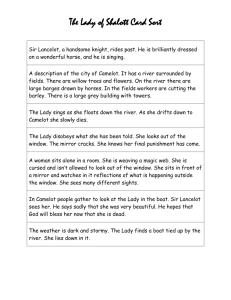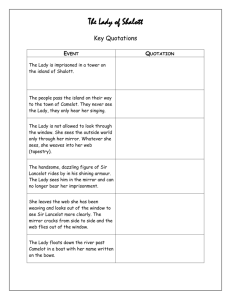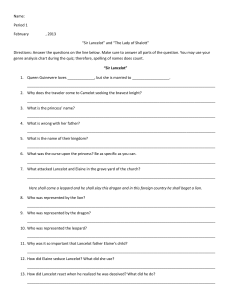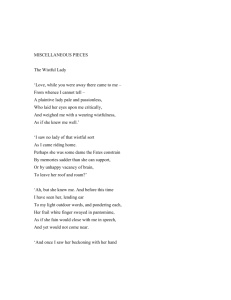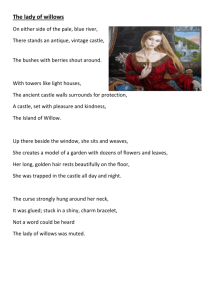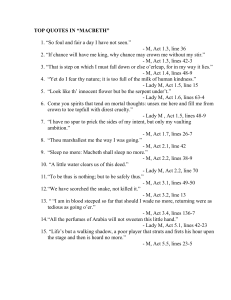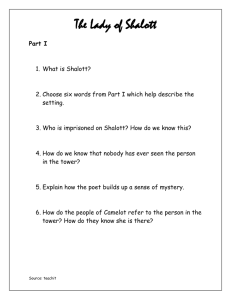LadyofShalott
advertisement
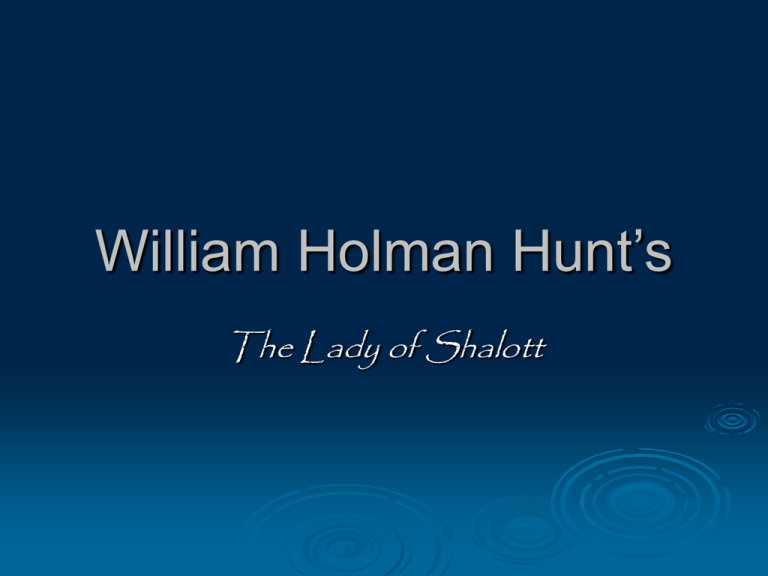
William Holman Hunt’s The Lady of Shalott Hunt Biography Born 1827- Died 1910, British painter and founder of the Pre-Rafaelite Brotherhood with Rosetti and Milais. They sought to portray a detailed observation of the natural world with a religious devotion to truth. Highly influenced by medieval art, partly because it removed them from the problems and “ugliness” of the industrial world. Hunt received early fame for naturalistic paintings of rural life and for his religious paintings. Noted for their attention to detail, vivid color, and elaborate symbolism. Influenced by Ruskin and Carlyle and the belief that the world could be interpreted as a system of visual signs. His last major work, The Lady Of Shalott, was completed with the help of assistants because of Hunt’s failing sight. Based on Tennyson’s 1842 poem, loosely based on Malory’s Mort d’ Arthur and the Italian novelette Donna di Scalotta, about Elaine of Astolat who falls in love with Lancelot and dies of unrequited love. In the poem, the Lady lives on an island near Camelot , cursed to never look directly at Camelot, but view the world in a mirror and weave what she sees in a magic web. One day, she sees Lancelot riding toward Camelot, and realizes how sick she is of seeing the world through shadows and reflections. Temptation gets the best of her and she looks out the window toward Lancelot, bringing the curse upon her. She leaves the tower and finds a boat, upon which she writes her name, and drifts toward Camelot, dying as she sings her mournful song Hunt’s painting depicts the climatic moment the Lady looks toward Lancelot, and is cursed…. She left the web, she left the loom, She made three paces through the room, She saw the water-lily bloom, She saw the helmet and the plume, She look’d down to Camelot. Out flew the web and floated wide; The mirror crack’d from side to side; ‘The curse is come upon me,’ cried The Lady of Shalott. The poem was extremely popular with pre-Rafaelite painters and Hunt himself returned to the image at several points in his career. The story was attractive because of the sorrowful aspects of love and the idea of the isolated and unattainable woman. The ‘fallen woman’ was key to this brotherhood of painters, and the image of a woman at a window reflected the separation between a woman’s interior and exterior worlds. Hunt’s painting more accurately depicts, not the moment she sees Lancelot, but the moment she recognizes the fulfillment of the curse, and knows her fate. The Lady’s hair is wild and tempestuous reflecting her inner emotional state, and she attempts to break free of the web with an outstretched hand that wards off impending danger. It is interesting to realize that the only image we have of Lancelot is in the mirror. In the mirror, as opposed to the what is happening in the room, the Lady appears to be headed toward Lancelot and the outside world. So the two appear briefly together, though a column clearly separates them. It is important to note, however, that Lancelot is riding away, his back turned toward the woman in her state of peril. The mirror behind the Lady is juxtaposed by the space she inhabits. The wide, open, and bright image of the outside world is contrasted with the claustrophobia of the Lady’s tower. Her hair frightens away the doves of peace that have settled around her, and the ruined tapestry reflects the ruin of her own life. The lamp to her side depicts sphinxes at the bottom and owls at the top signifying wisdom over mystery, the light having gone out now that the lady has given in to temptation. The frames on either side of the mirror depict images from the Bible and from classical mythology. To the left, is the Madonna and child, signifying humility. To the right, Heracles’ victory over the serpent that guards the apples in the garden of the Hesperides., signifying valor. Heracles is haloed, the pagan equivalent to Christ and his victory over sin. Both are images of duty, which contrast to the temptation and fall of the Lady. In addition to being the story of the fallen woman, the journey from innocence, to seduction, sexual awakening, abandonment, despair, and either suicide or salvation, it is also an exploration of the duties of artist and the dangers of personal isolation. At what point does the artist need to stop mirroring the world, and start living in it? http://www.victorianweb.org/painting/whh/by ecroft2.html http://penelope.uchicago.edu/~grout/encyclo paedia_romana/britannia/saxonadvent/hun t.html http://en.wikipedia.org/wiki/The_Lady_of_Sh alott
